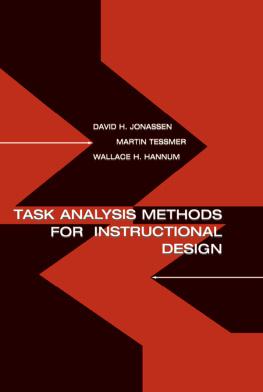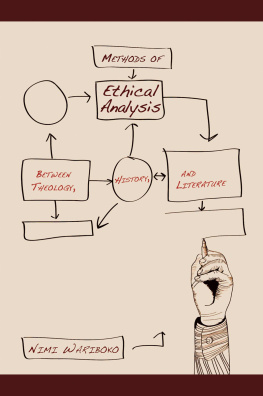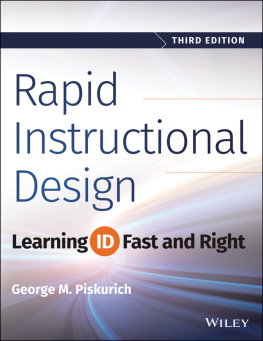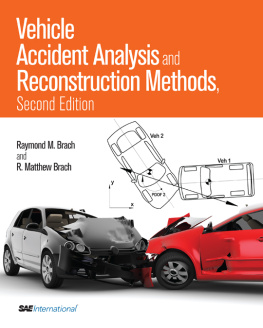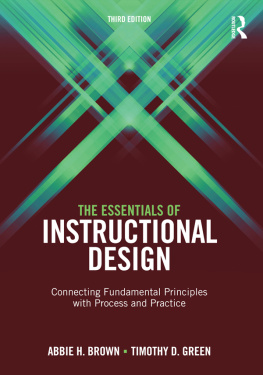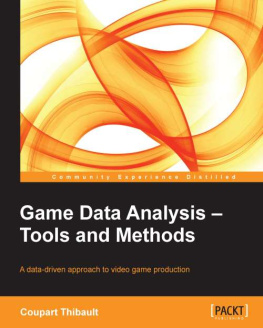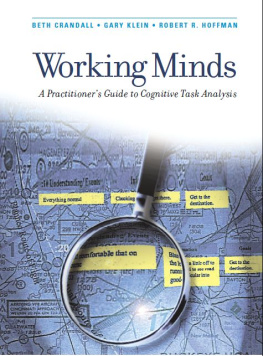Task Analysis Methods for
Instructional Design
Task Analysis Methods for
Instructional Design
David H. Jonassen
The Pennsylvania State University
Martin Tessmer
University of South Alabama
Wallace H. Hannum
University of North Carolina
First Published by
Lawrence Erlbaum Associates, Inc., Publishers
10 Industrial Avenue
Mahwah, New Jersey 07430
Transferred to Digital Printing 2009 by Routledge
270 Madison Ave, New York NY 10016
2 Park Square, Milton Park, Abingdon, Oxon, OX14 4RN
Copyright 1999 by Lawrence Erlbaum Associates, Inc.
All rights reserved. No part of this book may be reproduced
in any form, by photostat, microform, retrieval system, or any
other means, without the prior written permission of
the publisher.
Library of Congress Cataloging-in-Publication Data
Jonassen, David H., 1947
Task analysis methods for instructional design/ David H.
Jonassen, Martin Tessmer, Wallace H. Hannum.
p. cm.
Includes bibliographical references and index.
1. Instructional systems--Design. 2. Task analysis in education.
I. Tessmer, Martin. II. Hannum, Wallace H. III. Title.
LB1028.38.J65 1999
370.1523-dc21
98-42227
CIP
ISBN 0-805-83085-5
Publishers Note
The publisher has gone to great lengths to ensure the quality of this reprint but points out that some imperfections in the original may be apparent.
Contents
The major premise of this book is our belief that task analysis is the single most important component process in instructional design process, whether that process is used to produce direct instruction, performance support, or constructivist learning environments. Yet there is less literature available on task analysis than any other component of instructional design.
Having identified learning needs in the instructional design process, instructional designers sometimes, though not always, conduct a task analysis. In conducting a task analysis, the designer should clarify the outcomes of instruction, decide which outcomes should be further analyzed and developed, analyze the components and requirements of those outcomes, arrange or rearrange those components into an instructional sequence, and determine the cognitive/affective/skill/learning requirements of those component tasks. The result of task analysis is a blueprint for instruction. Like an architect, the instructional designer uses task analysis as a framework for building an instructional lesson or a learning environment. Without a blueprint, important parts of the lesson may be ignored, or the components and activities may not support each other. After completing the task analysis, the designer usually identifies instructional strategies and activities to engage and facilitate the learning requirements that were identified by the task analysis. The instructional designer is also responsible for developing and producing instructional materials for the learners and evaluating the effectiveness of them. Task analysis orients these processes.
The second premise of this book is that task analysis, although the most important, is the most often misconstrued, misinterpreted, poorly executed, or simply ignored component of the instructional design process. Why? First, there is a dearth of literature available to designers. Second, task analysis receives insufficient attention in preparation programs in instructional design. Third, it is a complex process which is filled with uncertainty and ambiguity. Fourth, task analysis requires a lot of time, effort, and expertise. Because of these difficulties, task analysis is frequently ignored. Designers begin designing and producing materials without a plan or instructional blueprint. If a task analysis is conducted, it is often not allocated the time and resources necessary to perform it competently. Even if it is performed competently, task analysis doesnt guarantee good instruction. Good instruction design depends upon task analysis, but task analysis doesnt assure good instruction. There are too many other processes that affect instructional outcomes. In summary, we believe that task analysis is a necessary but not sufficient requirement of good instruction.
Our beliefs are tempered by the assumption that not all designers, managers, trainers, educators, and human resource developers believe our first two premises. Many educators and trainers are not convinced that task analysis is worth the effort. Task analysis, needs analysis, and other front end processes do not produce tangible instructional products or results, so trainers often do not believe that they are worth the effort. Instructional products are confused with the bottom line. We believe that such thinking represents a false economy of effort. The real effects of deficient task analysis are not obvious until the learners have to perform, and they cannot because the instruction they received is inadequate. A poorly executed task analysis often results in gaps in the instructional sequence, because elements of the task were not revealed by the analysis. Gaps in the instructional sequence result in insufficient learning and subsequent deficient performance. Task analysis is frequently ignored or performed perfunctorily, because designers or supervisors do not believe that it is essential to good instruction. Even if they ascribe importance to task analysis, they seldom assign enough time and resources to conduct an adequate task analysis. The compulsion to provide training products often precludes careful task analysis.
The most difficult part of task analysis may be convincing your supervisor, manager, superintendent, or employer that a competent task analysis is necessary and therefore important enough to commit adequate time and resources to. If you are convincing enough, then this book is for you.
This book is designed to serve three purposes. The first purpose is to define task analysis. In the of the book, we describe information gathering and knowledge elicitation tools that support the task analysis techniques described in the previous four parts.
The second purpose of this book is to serve as an instructional text. In each chapter, we provide examples and verbal descriptions of how to perform each task analysis method. We have provided relatively skeletal representations. We preferred to provide more examples, along with adequate practice and feedback, in order to make the book more instructionally effective. To do so would have doubled or tripled the page length, making this volume unaffordable to the audience for whom it was intended students and novice practitioners of instructional design. You can certainly learn about each of the methods from this book. In order to become skilled, you will have to consult the references provided in each chapter, and you will certainly have to practice using the techniques. We urge you to go beyond this book in your learning.
The third purpose of this book is to serve as a reference book of task analysis. Each chapter has a similar chapter structure with headings and other typographic cues that help you to find information about each technique. These cues should enable you find the information that you need when you want it. The book is, perhaps more than anything else, a handbook.
So, if you agree with us that task analysis is an important component of instructional design, we encourage you to use this manual to discover more about the many ways in which it is performed.
Acknowledgements
We would like to acknowledge many of our more querulous students, whose uncertainty with the perplexing array of task analysis procedures prompted the writing of this book. We express our thanks to Valerie J. Shute, Ross E. Willis, Lisa A. Torreano, Lucia Rohrer-Murphy, Laura Militello, and Beth Crandall who helped us author three of the chapters. Their perspectives were cutting edge, so they helped us to get it right. We would also like to thank Ikseon Choi, Julian Hernandez-Serrano, Doug Harvey, and Jaison Williams for the examples they provided in two of the chapters. Finally, we are indebted to the many practitioners and scholars who also have struggled through the years to articulate the many analytic procedures represented in this book.

